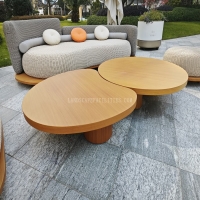Welcome to the website for landscape facilities products and knowledge.
What are the best practices for ensuring landscape tables are resistant to fungal growth?
Landscape tables are a beautiful addition to outdoor spaces, but they are often exposed to moisture and humidity, making them susceptible to fungal growth. To ensure your tables remain durable and aesthetically pleasing, follow these best practices:
1. Choose the Right Materials: Opt for naturally resistant woods like cedar, redwood, or teak, or consider synthetic materials such as recycled plastic or metal, which are less prone to fungal attacks.
2. Apply Protective Coatings: Regularly treat wooden tables with water-resistant sealants, fungicidal paints, or oils like linseed or tung oil to create a barrier against moisture and fungi.
3. Ensure Proper Drainage: Design or position tables with slight slopes or gaps to prevent water pooling, which can accelerate fungal growth.
4. Regular Cleaning: Clean surfaces frequently with a mixture of vinegar and water or a mild bleach solution to remove spores and prevent mold buildup.
5. Promote Air Circulation: Avoid placing tables in damp, shaded areas. Instead, position them where sunlight and airflow can help keep surfaces dry.
By implementing these strategies, you can significantly extend the lifespan of your landscape tables while maintaining their beauty and functionality.
Related search:

Recommendation
Elliptical metal outdoor table with nested design, resembling wood grain, round table